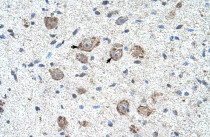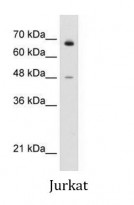ARG42145
anti-KLHL25 antibody
anti-KLHL25 antibody for IHC-Formalin-fixed paraffin-embedded sections,Western blot and Human
Overview
| Product Description | Rabbit Polyclonal antibody recognizes KLHL25 |
|---|---|
| Tested Reactivity | Hu |
| Predict Reactivity | Ms, Rat, Cow, Dog, Gpig, Pig, Rb |
| Tested Application | IHC-P, WB |
| Host | Rabbit |
| Clonality | Polyclonal |
| Isotype | IgG |
| Target Name | KLHL25 |
| Antigen Species | Human |
| Immunogen | Synthetic peptide around the N-terminal region of Human KLHL25. (within the following region: RLYEF SWRMC LVHFE TVRQS EDFNS LSKDT LLDLI SSDEL ETEDE RVVFE) |
| Conjugation | Un-conjugated |
| Alternate Names | ENC-2; Kelch-like protein 25; ENC2; Ectoderm-neural cortex protein 2 |
Application Instructions
| Predict Reactivity Note | Predicted Homology Based on Immunogen Sequence: Cow: 93%; Dog: 100%; Guinea pig: 93%; Mouse: 86%; Pig: 100%; Rabbit: 86%; Rat: 86% | ||||||
|---|---|---|---|---|---|---|---|
| Application Suggestion |
|
||||||
| Application Note | * The dilutions indicate recommended starting dilutions and the optimal dilutions or concentrations should be determined by the scientist. | ||||||
| Positive Control | Jurkat | ||||||
| Observed Size | ~ 67 kDa |
Properties
| Form | Liquid |
|---|---|
| Purification | Purification with Protein A. |
| Buffer | PBS, 0.09% (w/v) Sodium azide and 2% Sucrose. |
| Preservative | 0.09% (w/v) Sodium azide |
| Stabilizer | 2% Sucrose |
| Concentration | Batch dependent: 0.5 - 1 mg/ml |
| Storage Instruction | For continuous use, store undiluted antibody at 2-8°C for up to a week. For long-term storage, aliquot and store at -20°C or below. Storage in frost free freezers is not recommended. Avoid repeated freeze/thaw cycles. Suggest spin the vial prior to opening. The antibody solution should be gently mixed before use. |
| Note | For laboratory research only, not for drug, diagnostic or other use. |
Bioinformation
| Database Links | |
|---|---|
| Gene Symbol | KLHL25 |
| Gene Full Name | kelch-like family member 25 |
| Function | Substrate-specific adapter of a BCR (BTB-CUL3-RBX1) E3 ubiquitin ligase complex required for translational homeostasis. The BCR(KLHL25) ubiquitin ligase complex acts by mediating ubiquitination of hypophosphorylated EIF4EBP1 (4E-BP1): ubiquitination and subsequent degradation of hypophosphorylated EIF4EBP1 (4E-BP1) probably serves as a homeostatic mechanism to maintain translation and prevent eIF4E inhibition when eIF4E levels are low. The BCR(KLHL25) complex does not target EIF4EBP1 (4E-BP1) when it is hyperphosphorylated or associated with eIF4E. [UniProt] |
| Calculated MW | 66 kDa |
Images (2) Click the Picture to Zoom In







